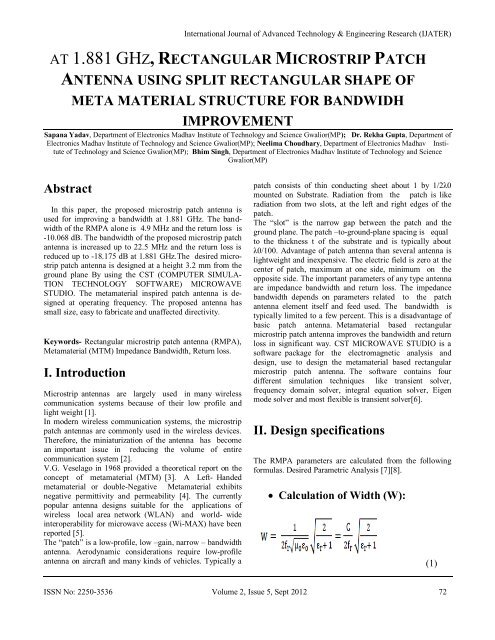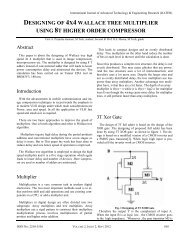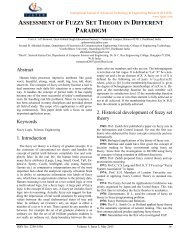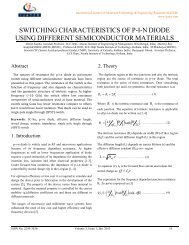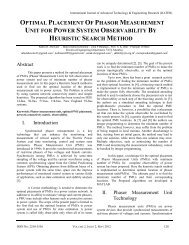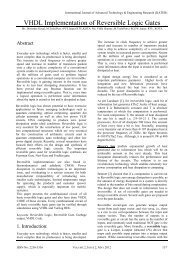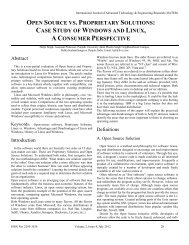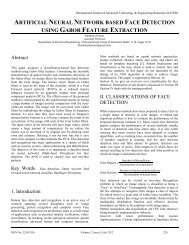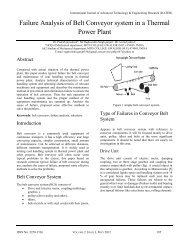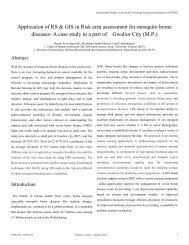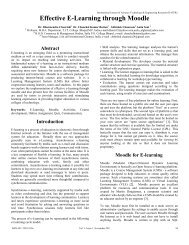at 1.881 ghz, rectangular microstrip patch antenna using split ... - ijater
at 1.881 ghz, rectangular microstrip patch antenna using split ... - ijater
at 1.881 ghz, rectangular microstrip patch antenna using split ... - ijater
- No tags were found...
You also want an ePaper? Increase the reach of your titles
YUMPU automatically turns print PDFs into web optimized ePapers that Google loves.
Intern<strong>at</strong>ional Journal of Advanced Technology & Engineering Research (IJATER)AT <strong>1.881</strong> GHZ, RECTANGULAR MICROSTRIP PATCHANTENNA USING SPLIT RECTANGULAR SHAPE OFMETA MATERIAL STRUCTURE FOR BANDWIDHIMPROVEMENTSapana Yadav, Department of Electronics Madhav Institute of Technology and Science Gwalior(MP); Dr. Rekha Gupta, Department ofElectronics Madhav Institute of Technology and Science Gwalior(MP); Neelima Choudhary, Department of Electronics Madhav Instituteof Technology and Science Gwalior(MP); Bhim Singh, Department of Electronics Madhav Institute of Technology and ScienceGwalior(MP)AbstractIn this paper, the proposed <strong>microstrip</strong> p<strong>at</strong>ch <strong>antenna</strong> isused for improving a bandwidth <strong>at</strong> <strong>1.881</strong> GHz. The bandwidthof the RMPA alone is 4.9 MHz and the return loss is-10.068 dB. The bandwidth of the proposed <strong>microstrip</strong> p<strong>at</strong>ch<strong>antenna</strong> is increased up to 22.5 MHz and the return loss isreduced up to -18.175 dB <strong>at</strong> <strong>1.881</strong> GHz.The desired <strong>microstrip</strong>p<strong>at</strong>ch <strong>antenna</strong> is designed <strong>at</strong> a height 3.2 mm from theground plane By <strong>using</strong> the CST (COMPUTER SIMULA-TION TECHNOLOGY SOFTWARE) MICROWAVESTUDIO. The metam<strong>at</strong>erial inspired p<strong>at</strong>ch <strong>antenna</strong> is designed<strong>at</strong> oper<strong>at</strong>ing frequency. The proposed <strong>antenna</strong> hassmall size, easy to fabric<strong>at</strong>e and unaffected directivity.Keywords- Rectangular <strong>microstrip</strong> p<strong>at</strong>ch <strong>antenna</strong> (RMPA),Metam<strong>at</strong>erial (MTM) Impedance Bandwidth, Return loss.I. IntroductionMicrostrip <strong>antenna</strong>s are largely used in many wirelesscommunic<strong>at</strong>ion systems because of their low profile andlight weight [1].In modern wireless communic<strong>at</strong>ion systems, the <strong>microstrip</strong>p<strong>at</strong>ch <strong>antenna</strong>s are commonly used in the wireless devices.Therefore, the mini<strong>at</strong>uriz<strong>at</strong>ion of the <strong>antenna</strong> has becomean important issue in reducing the volume of entirecommunic<strong>at</strong>ion system [2].V.G. Veselago in 1968 provided a theoretical report on theconcept of metam<strong>at</strong>erial (MTM) [3]. A Left- Handedmetam<strong>at</strong>erial or double-Neg<strong>at</strong>ive Metam<strong>at</strong>erial exhibitsneg<strong>at</strong>ive permittivity and permeability [4]. The currentlypopular <strong>antenna</strong> designs suitable for the applic<strong>at</strong>ions ofwireless local area network (WLAN) and world- wideinteroperability for microwave access (Wi-MAX) have beenreported [5].The “p<strong>at</strong>ch” is a low-profile, low –gain, narrow – bandwidth<strong>antenna</strong>. Aerodynamic consider<strong>at</strong>ions require low-profile<strong>antenna</strong> on aircraft and many kinds of vehicles. Typically ap<strong>at</strong>ch consists of thin conducting sheet about 1 by 1/2λ0mounted on Substr<strong>at</strong>e. Radi<strong>at</strong>ion from the p<strong>at</strong>ch is likeradi<strong>at</strong>ion from two slots, <strong>at</strong> the left and right edges of thep<strong>at</strong>ch.The “slot” is the narrow gap between the p<strong>at</strong>ch and theground plane. The p<strong>at</strong>ch –to-ground-plane spacing is equalto the thickness t of the substr<strong>at</strong>e and is typically aboutλ0/100. Advantage of p<strong>at</strong>ch <strong>antenna</strong> than several <strong>antenna</strong> islightweight and inexpensive. The electric field is zero <strong>at</strong> thecenter of p<strong>at</strong>ch, maximum <strong>at</strong> one side, minimum on theopposite side. The important parameters of any type <strong>antenna</strong>are impedance bandwidth and return loss. The impedancebandwidth depends on parameters rel<strong>at</strong>ed to the p<strong>at</strong>ch<strong>antenna</strong> element itself and feed used. The bandwidth istypically limited to a few percent. This is a disadvantage ofbasic p<strong>at</strong>ch <strong>antenna</strong>. Metam<strong>at</strong>erial based <strong>rectangular</strong><strong>microstrip</strong> p<strong>at</strong>ch <strong>antenna</strong> improves the bandwidth and returnloss in significant way. CST MICROWAVE STUDIO is asoftware package for the electromagnetic analysis anddesign, use to design the metam<strong>at</strong>erial based <strong>rectangular</strong><strong>microstrip</strong> p<strong>at</strong>ch <strong>antenna</strong>. The software contains fourdifferent simul<strong>at</strong>ion techniques like transient solver,frequency domain solver, integral equ<strong>at</strong>ion solver, Eigenmode solver and most flexible is transient solver[6].II. Design specific<strong>at</strong>ionsThe RMPA parameters are calcul<strong>at</strong>ed from the followingformulas. Desired Parametric Analysis [7][8]. Calcul<strong>at</strong>ion of Width (W):(1)ISSN No: 2250-3536 Volume 2, Issue 5, Sept 2012 72
Intern<strong>at</strong>ional Journal of Advanced Technology & Engineering Research (IJATER)WhereC = free space velocity of light,Ɛr =Dielectric constant of substr<strong>at</strong>e The effective dielectric constant ofthe <strong>rectangular</strong> <strong>microstrip</strong> p<strong>at</strong>ch<strong>antenna</strong>:(2) Actual length of the p<strong>at</strong>ch (L):Table1.Rectangular Microstrip P<strong>at</strong>ch Antenna Specific<strong>at</strong>ionsParameters Dimension UnitDielectric constant4.3 -Loss tangent .02 -(tan )Thickness (h) 1.6 MmOper<strong>at</strong>ing <strong>1.881</strong> GHzFrequencyLength L 35.85 MmWidth W 46.07 MmCut width 5 MmCut depth 10 MmP<strong>at</strong>h length 33.58 Mm(3) Calcul<strong>at</strong>ion of length extension:(4)III. Analysis of RectangularMicrostrip P<strong>at</strong>ch Antenna andMetam<strong>at</strong>erial Structure withSimul<strong>at</strong>ed ResultsThe Rectangular Microstrip P<strong>at</strong>ch Antenna is designedon FR-4 (Lossy) substr<strong>at</strong>e <strong>at</strong> 50Ω m<strong>at</strong>ching impedance,dielectric constant εr = 4.3 and height from the ground planed=1.6mm.The parameter of <strong>rectangular</strong> <strong>microstrip</strong> p<strong>at</strong>ch<strong>antenna</strong> are L= 35.8462 mm, W= 46.0721 mm, CutWidth= 5mm, Cut Depth= 10mm, length of transmissionline feed= 33.58mm, with width of the feed= 3.05mmshown in figure1.The simple RMPA is inspired by metam<strong>at</strong>erial structure <strong>at</strong><strong>1.881</strong> GHz.Figure1. Rectangular <strong>microstrip</strong> p<strong>at</strong>ch <strong>antenna</strong> <strong>at</strong> <strong>1.881</strong> GHz.CST-software is used to design the Rectangular <strong>microstrip</strong>p<strong>at</strong>ch <strong>antenna</strong> (RMPA) <strong>at</strong> opr<strong>at</strong>ing frequency <strong>1.881</strong> GHz.However, their employment raises some problems, such as,difficulty impedance m<strong>at</strong>ching or increasing of surfacewaves in the Substr<strong>at</strong>e th<strong>at</strong> could decline the radi<strong>at</strong>ionefficiency and the radi<strong>at</strong>ion p<strong>at</strong>tern. Bandwidth of the<strong>antenna</strong> may be considerably becomes worse [9].Simul<strong>at</strong>ed result of Return loss and bandwidth ofRectangular Microstrip P<strong>at</strong>ch <strong>antenna</strong>(RMPA) is shown infig 2.ISSN No: 2250-3536 Volume 2, Issue 5, Sept 2012 73
Intern<strong>at</strong>ional Journal of Advanced Technology & Engineering Research (IJATER)Figure 2. Simul<strong>at</strong>ion of return loss and bandwidth of RMPA.Figure 4. E- field in RMPA alone <strong>at</strong> <strong>1.881</strong> GHz.The bandwidth of simple RMPA is 4.9 MHz and Return lossis -10.068 dB.The Rectangular <strong>microstrip</strong> p<strong>at</strong>ch <strong>antenna</strong> has 3D Radi<strong>at</strong>ionp<strong>at</strong>tern <strong>at</strong> <strong>1.881</strong> GHz as shown in figure3. The radi<strong>at</strong>ionp<strong>at</strong>tern shows the directivity of simple RMPA is 6.875 dBi.Figure 3. Radi<strong>at</strong>ion p<strong>at</strong>tern of RMPA <strong>at</strong> 1.794 GHz.Figure 5. H- field in RMPA alone in <strong>1.881</strong> GHzISSN No: 2250-3536 Volume 2, Issue 5, Sept 2012 74
Intern<strong>at</strong>ional Journal of Advanced Technology & Engineering Research (IJATER)Figure 6. S-parameter in RMPA alone in <strong>1.881</strong> GHz.Figure 9. Design of proposed metam<strong>at</strong>erial structure <strong>at</strong> theheight of 3.2 mm from ground plane.In this metam<strong>at</strong>erial design, <strong>split</strong> <strong>rectangular</strong> shape areloaded on the p<strong>at</strong>ch <strong>antenna</strong>. There are two parallel striplines which are equally distributed from the center andanother strip line is centred between two parallel line, and a<strong>split</strong> <strong>rectangular</strong> structure on the FR-4 lossy <strong>at</strong> a height 3.2mm from the ground plane .This design gives the better improvementin impedance bandwidth and reduction in returnloss.Figure 7. Smith chart in RMPA alone in <strong>1.881</strong> GHz.Figure 8. Delivered power to RMPA. The maximum powerdeliver to p<strong>at</strong>ch <strong>antenna</strong> is above 0.95 w<strong>at</strong>t.Figure 10. Rectangular <strong>microstrip</strong> p<strong>at</strong>ch <strong>antenna</strong> with proposedmetam<strong>at</strong>erial structure.ISSN No: 2250-3536 Volume 2, Issue 5, Sept 2012 75
Simul<strong>at</strong>ion result of Return loss and bandwidth ofRectangular <strong>microstrip</strong> p<strong>at</strong>ch <strong>antenna</strong> loaded withmetam<strong>at</strong>erial structure is shown in Fig 11.The proposed metam<strong>at</strong>erial structure reduces the return lossby -8.107dB and increases the bandwidth up to 17.96 MHz.Intern<strong>at</strong>ional Journal of Advanced Technology & Engineering Research (IJATER)Figure13. H Field of the reduced size RMPA loaded withMetam<strong>at</strong>erialFigure 11. Simul<strong>at</strong>ion of Return loss and impedance bandwidthof RMPA with proposed metem<strong>at</strong>erial structure <strong>at</strong> oper<strong>at</strong>ingfrequency <strong>1.881</strong> GHz.The Simul<strong>at</strong>ed result of RMPA <strong>using</strong> <strong>split</strong> <strong>rectangular</strong> shapeis reduced return loss of -18.175 dB and Bandwidth of 22.5MHz.It is clear th<strong>at</strong> the Directivity of proposed <strong>antenna</strong> is almostunaffected in comparison to simple RMPA alone.Figure14. H Field of the reduced size RMPA loaded withMetam<strong>at</strong>erial.Figure 12. Radi<strong>at</strong>ion p<strong>at</strong>tern of proposed <strong>antenna</strong> showingDirectivity of 6.784 dBi.ISSN No: 2250-3536 Volume 2, Issue 5, Sept 2012 76
Intern<strong>at</strong>ional Journal of Advanced Technology & Engineering Research (IJATER)IV. Simul<strong>at</strong>ion ResultsIn this paper, Rectangular <strong>microstrip</strong> p<strong>at</strong>ch <strong>antenna</strong> <strong>using</strong><strong>split</strong> <strong>rectangular</strong> shape of metam<strong>at</strong>erial for bandwidthimprovement <strong>at</strong> <strong>1.881</strong> GHz is simul<strong>at</strong>ed <strong>using</strong> CST-MWSsoftware. The proposed design in comparison to RMPAalone, found th<strong>at</strong> the potential parameters of the proposed<strong>antenna</strong> is increased. This is clear from Fig.2 & Fig.11 th<strong>at</strong>the return loss is reduced from -10.068 dB to -18.175 dB,and bandwidth is increased from 4.9 MHz to 22.5 MHz.From the Fig.12, it is clear th<strong>at</strong> the Directivity of proposed<strong>antenna</strong> design is almost unaffected. The maximum powerdeliver to proposed <strong>rectangular</strong> <strong>microstrip</strong> p<strong>at</strong>ch <strong>antenna</strong>is above 0.95 w<strong>at</strong>t.V. ConclusionFigure 15. Smith chart of simple Rectangular <strong>microstrip</strong> p<strong>at</strong>ch<strong>antenna</strong>.The bandwidth of the proposed <strong>microstrip</strong> p<strong>at</strong>ch<strong>antenna</strong> is increased by <strong>using</strong> meta m<strong>at</strong>erial and thereturn loss is reduced <strong>at</strong> oper<strong>at</strong>ing frequency anddirectivity is unaffected. Due to this, Rectangular<strong>microstrip</strong> p<strong>at</strong>ch <strong>antenna</strong> <strong>using</strong> SPLIT RECTANGU-LAR SHAPE of metam<strong>at</strong>erial for bandwidth improvement.By <strong>using</strong> Metam<strong>at</strong>erial, the maximumpower delivered to proposed <strong>antenna</strong> is 1 w<strong>at</strong>t as comparedto the RMPA delivered power above the 0.95w<strong>at</strong>t.VI. AcknowledgementFigure 16. Smith chart of simple Rectangular <strong>microstrip</strong> p<strong>at</strong>ch<strong>antenna</strong>.The smith chart is very useful when solving transmissionproblems. The real utility of the Smith chart, it can be usedto convert from reflection coefficients to normalizedimpedances (or admittances), and vice versa.Smith chart of RMPA <strong>using</strong> <strong>split</strong> <strong>rectangular</strong> shape forbandwidth improvement <strong>at</strong> <strong>1.881</strong> GHz. Above Fig. showsthe impedance vari<strong>at</strong>ion in the simul<strong>at</strong>ed frequency rangeand received impedance m<strong>at</strong>ching for proposed <strong>antenna</strong> <strong>at</strong>characteristic impedance.The authors wish to thank their parents for their constantmotiv<strong>at</strong>ion without which this work would have never beencompleted. The authors are gr<strong>at</strong>eful to the Dr. Sanjeev JainDirector MITS Gwalior for providing us lab facilities tocomplete this project work. We also express our gr<strong>at</strong>itudetowards Dr. P K Singhal HOD Dept. of Elex MITS and Dr.Sarita S Bhadoria Professor Dept. of Elex, MITS for theircontinued support and guidance. Finally we thank ourfriends Mr. Harshal Mishra and Mr. Mohan Choudhary fortheir moral support and help during this project.VII. References[1] Douglas, H. W., R. L. Haupt, and P. L. Werner,Fractal <strong>antenna</strong> engineering: The theory and design offractal <strong>antenna</strong> arrays," IEEE Antennas andPropag<strong>at</strong>ion Magazine, Vol. 41, No. 5, 37-59, 1999.[2] H.A. Jang, D.O. Kim , and C. Y. Kim “ SizeReduction of P<strong>at</strong>ch Antenna Array Using CSRRsLoaded Ground Plane”Progress In ElectromagneticsISSN No: 2250-3536 Volume 2, Issue 5, Sept 2012 77
Intern<strong>at</strong>ional Journal of Advanced Technology & Engineering Research (IJATER)Research Symposium Proceedings, KL MALAYSIA,March 27-30, 2012 1487.[3] Veselago, V. G., The electrodynamics of substances,with simultaneously neg<strong>at</strong>ive values of ɛ and µ"Soviet Physics Uspekhi , Vol. 10, No. 4 , 509-514,1968.[4] R.W. Ziolkowski, “Design fabric<strong>at</strong>ing and fabric<strong>at</strong>ionand testing of double neg<strong>at</strong>ive metam<strong>at</strong>erials ,” IEEETransactions on <strong>antenna</strong>s and Propag<strong>at</strong>ion, vol.51,no.7, pp.1516-1529, July 2005.[5] Kuo, Y. L. and K. L. Wong, Printed double- Tmonopole <strong>antenna</strong> for 2.4/5.2 GHz dual-band WLANoper<strong>at</strong>ions," IEEE Trans. Antennas Propag., Vol. 51,No. 9, 2187-2192.[6] Dr. Rekha Gupta, Bhim Singh, Neelima ChoudharySapana Yadav “Rectangular <strong>microstrip</strong> p<strong>at</strong>ch <strong>antenna</strong>loaded with Symmetrically cut H and Hexagonalshaped Metam<strong>at</strong>erial structure for bandwidth improvement<strong>at</strong> 1.794 GHz”, Intern<strong>at</strong>ional Journal ofAdvanced Technology & Engineering Re-search(IJATER), ISSN No: 2250-3536 , Volume 2, Issue 5,Sept 2012.[7] Constantine A. Balanis, Antenna Theory and Design,John Wiley & Sons, Inc., 1997.NEELIMA CHOUDHARY received the B.E degree inInform<strong>at</strong>ion and Technology from R.G.P.V Bhopal M.P. in2009. Currently she is pursuing M.Tech in Communic<strong>at</strong>ionControl and Networking from MITS Gwalior, Bhopal,(M.P). Her research interest includes Antenna andMicrowave communic<strong>at</strong>ion and their applic<strong>at</strong>ions.Neelima choudhary can be reached <strong>at</strong>nisha_mits29@rediff.comBHIM SINGH received the B.Tech degree in Electronicsand Communic<strong>at</strong>ion from Bundelkhand University JhansiUtter Pradesh in 2009. At present he is pursuing M.Tech inCommunic<strong>at</strong>ion, Control and Networking from MITSGwalior, Bhopal, (M.P). His research interest includesAntenna and Micro wave communic<strong>at</strong>ion and theirapplic<strong>at</strong>ions. Bhim Singh may be reached <strong>at</strong>singhbhim16@gmail.com[8] .L. Stutzman, G.A. Thiele, Antenna Theory anddesign , John Wiley & Sons 2nd Ed., New York,1998.[9] J. S. Colburn and Y. Rahm<strong>at</strong>-Samii, “P<strong>at</strong>ch <strong>antenna</strong>son externally perfor<strong>at</strong>ed high dielectric constantSubstr<strong>at</strong>es IEEE Trans. Antennas Propag.,, vol. 47,no. 12, pp 1785–1794, 1999.BiographiesDR. REKHA GUPTA is currently associ<strong>at</strong>ed with MITS,Gwalior as a Senior Faculty of Electronics andCommunic<strong>at</strong>ion Department. She has done Ph.D in wirelesscommunic<strong>at</strong>ion from R.G.P.V. Her research interestsinclude Antenna and Microwave communic<strong>at</strong>ion, wirelesscommunic<strong>at</strong>ion and their applic<strong>at</strong>ions. Dr.Rekha Guptamay be reached <strong>at</strong> rekha652003@yahoo.comSAPANA YADAV received the B.E degree in Electronicsand communic<strong>at</strong>ion from RGPV, Bhopal M.P in 2009.Currently she is pursuing M.Tech in Communic<strong>at</strong>ion,Control and Networking from MITS Gwalior, Bhopal,(M.P).Her research interest includes Antenna and Microwavecommunic<strong>at</strong>ion and their applic<strong>at</strong>ions. Sapana Yadav maybe reached <strong>at</strong> sapanayadav12@gmail.comISSN No: 2250-3536 Volume 2, Issue 5, Sept 2012 78


